High-Performance Flexible Transparent Electrodes Fabricated via Laser Nano-Welding of Silver Nanowires
Abstract
:1. Introduction
2. Materials and Methods
3. Results and Discussion
3.1. Morphology of Laser Nano-Welded Ag-NWs
3.2. Mechanism of Laser Nano-Welding of Ag-NWs on PMMA
3.3. Synthesis Optimization of Ag-NWs/PMMA/PDMS FTEs
3.4. Durability of Ag-NWs/PMMA/PDMS FTEs
3.5. Applications of Ag-NWs/PMMA/PDMS Films as High-Performance FTEs
4. Conclusions
Author Contributions
Funding
Data Availability Statement
Conflicts of Interest
References
- Chen, W.; Liu, L.X.; Zhang, H.B.; Yu, Z.Z. Flexible, Transparent, and Conductive Ti3C2Tx MXene-Silver Nanowire Films with Smart Acoustic Sensitivity for High-Performance Electromagnetic Interference Shielding. ACS Nano 2020, 14, 16643–16653. [Google Scholar] [CrossRef]
- Chen, X.; Xu, G.; Zeng, G.; Gu, H.; Chen, H.; Xu, H.; Yao, H.; Li, Y.; Hou, J.; Li, Y. Realizing Ultrahigh Mechanical Flexibility and >15% Efficiency of Flexible Organic Solar Cells via a “Welding” Flexible Transparent Electrode. Adv. Mater. 2020, 32, 1908478. [Google Scholar] [CrossRef]
- De Guzman, N.; Ramos, M., Jr.; Donnabelle Balela, M. Improvements in the electroless deposition of Ag nanowires in hot ethylene glycol for resistive touchscreen device. Mater. Res. Bull. 2018, 106, 446–454. [Google Scholar] [CrossRef]
- Sang, S.; Liu, L.; Jian, A.; Duan, Q.; Ji, J.; Zhang, Q.; Zhang, W. Highly sensitive wearable strain sensor based on silver nanowires and nanoparticles. Nanotechnology 2018, 29, 255202. [Google Scholar]
- Triambulo, R.E.; Kim, J.-H.; Park, J.-W. Highly flexible organic light-emitting diodes on patterned Ag nanowire network transparent electrodes. Org. Electron. 2019, 71, 220–226. [Google Scholar] [CrossRef]
- Hwang, Y.; Hwang, Y.H.; Choi, K.W.; Lee, S.; Kim, S.; Park, S.J.; Ju, B.-K. Highly stabilized flexible transparent capacitive photodetector based on silver nanowire/graphene hybrid electrodes. Sci. Rep. 2021, 11, 10499. [Google Scholar] [CrossRef]
- Ma, C.; Liu, H.; Teng, C.; Li, L.; Zhu, Y.; Yang, H.; Jiang, L. Wetting-Induced Fabrication of Graphene Hybrid with Conducting Polymers for High-Performance Flexible Transparent Electrodes. ACS Appl. Mater. Interfaces 2020, 12, 55372–55381. [Google Scholar] [CrossRef]
- Park, I.J.; Kim, T.I.; Yoon, T.; Kang, S.; Cho, H.; Cho, N.S.; Lee, J.I.; Kim, T.S.; Choi, S.Y. Flexible and Transparent Graphene Electrode Architecture with Selective Defect Decoration for Organic Light-Emitting Diodes. Adv. Funct. Mater. 2018, 28, 1704435. [Google Scholar] [CrossRef]
- Fang, Y.; Li, Y.; Wang, X.; Zhou, Z.; Zhang, K.; Zhou, J.; Hu, B. Cryo-Transferred Ultrathin and Stretchable Epidermal Electrodes. Small 2020, 16, 2000450. [Google Scholar] [CrossRef]
- Li, D.; Wang, L.; Ji, W.; Wang, H.; Yue, X.; Sun, Q.; Li, L.; Zhang, C.; Liu, J.; Lu, G.; et al. Embedding Silver Nanowires into a Hydroxypropyl Methyl Cellulose Film for Flexible Electrochromic Devices with High Electromechanical Stability. ACS Appl. Mater. Interfaces 2021, 13, 1735–1742. [Google Scholar] [CrossRef]
- Wang, S.; Wu, S.; Ling, Z.; Chen, H.; Lian, H.; Portier, X.; Gourbilleau, F.; Marszalek, T.; Zhu, F.; Wei, B.; et al. Mechanically and thermally stable, transparent electrodes with silver nanowires encapsulated by atomic layer deposited aluminium oxide for organic optoelectronic devices. Org. Electron. 2020, 78, 105593. [Google Scholar] [CrossRef] [Green Version]
- Zhang, Y.; Bai, S.; Chen, T.; Yang, H.; Guo, X. Facile preparation of flexible and highly stable graphene oxide-silver nanowire hybrid transparent conductive electrode. Mater. Res. Express 2020, 7, 016413. [Google Scholar] [CrossRef] [Green Version]
- Che, B.; Zhou, D.; Li, H.; He, C.; Liu, E.; Lu, X. A highly bendable transparent electrode for organic electrochromic devices. Org. Electron. 2019, 66, 86–93. [Google Scholar] [CrossRef]
- Jiang, S.; Hou, P.-X.; Chen, M.-L.; Wang, B.-W.; Sun, D.-M.; Tang, D.-M.; Jin, Q.; Guo, Q.-X.; Zhang, D.-D.; Du, J.-H.; et al. Ultrahigh-performance transparent conductive films of carbon-welded isolated single-wall carbon nanotubes. Sci. Adv. 2018, 4, eaap9264. [Google Scholar] [CrossRef] [Green Version]
- Khachatryan, H.; Kim, K.-B.; Kim, M. Fabrication of Flexible Carbon Nanotube Network on Paper Substrate: Effect of Post Treatment Temperature on Electrodes. J. Nanoelectron. Optoelecton. 2020, 15, 1442–1449. [Google Scholar] [CrossRef]
- Li, X.; Yu, S.; Zhao, L.; Wu, M.; Dong, H. Hybrid PEDOT:PSS to obtain high-performance Ag NW-based flexible transparent electrodes for transparent heaters. J. Mater. Sci. Mater. Electron. 2020, 31, 8106–8115. [Google Scholar] [CrossRef]
- Song, J.; Ma, G.; Qin, F.; Hu, L.; Luo, B.; Liu, T.; Yin, X.; Su, Z.; Zeng, Z.; Jiang, Y.; et al. High-Conductivity, Flexible and Transparent PEDOT:PSS Electrodes for High Performance Semi-Transparent Supercapacitors. Polymers 2020, 12, 450. [Google Scholar] [CrossRef] [Green Version]
- Yang, H.; Bai, S.; Chen, T.; Zhang, Y.; Wang, H.; Guo, X. Facile fabrication of large-scale silver nanowire-PEDOT:PSS composite flexible transparent electrodes for flexible touch panels. Mater. Res. Express 2019, 6, 086315. [Google Scholar] [CrossRef]
- Tan, D.; Jiang, C.; Li, Q.; Bi, S.; Song, J. Silver nanowire networks with preparations and applications: A review. J. Mater. Sci. Mater. Electron. 2020, 31, 15669–15696. [Google Scholar] [CrossRef]
- Park, J.; Hyun, B.G.; An, B.W.; Im, H.-G.; Park, Y.-G.; Jang, J.; Park, J.-U.; Bae, B.-S. Flexible Transparent Conductive Films with High Performance and Reliability Using Hybrid Structures of Continuous Metal Nanofiber Networks for Flexible Optoelectronics. ACS Appl. Mater. Interfaces 2017, 9, 20299–20305. [Google Scholar] [CrossRef] [PubMed]
- Kim, H.; Choi, S.-H.; Kim, M.; Park, J.-U.; Bae, J.; Park, J. Seed-mediated synthesis of ultra-long copper nanowires and their application as transparent conducting electrodes. Appl. Surf. Sci. 2017, 422, 731–737. [Google Scholar] [CrossRef]
- Ku, M.; Kim, J.; Won, J.-E.; Kang, W.; Park, Y.-G.; Park, J.; Lee, J.-H.; Cheon, J.; Lee, H.H.; Park, J.-U. Smart, soft contact lens for wireless immunosensing of cortisol. Sci. Adv. 2020, 6, eabb2891. [Google Scholar] [CrossRef]
- Kim, J.; Park, J.; Park, Y.-G.; Cha, E.; Ku, M.; An, H.S.; Lee, K.-P.; Huh, M.-I.; Kim, J.; Kim, T.-S.; et al. A soft and transparent contact lens for the wireless quantitative monitoring of intraocular pressure. Nat. Biomed. Eng. 2021, 5, 772–782. [Google Scholar] [CrossRef]
- Song, R.; Yao, S.; Liu, Y.; Wang, H.; Dong, J.; Zhu, Y.; O’Connor, B.T. Facile Approach to Fabricating Stretchable Organic Transistors with Laser-Patterned Ag Nanowire Electrodes. ACS Appl. Mater. Interfaces 2020, 12, 50675–50683. [Google Scholar] [CrossRef]
- Qiu, J.; Wang, X.; Ma, Y.; Yu, Z.; Li, T. Stretchable Transparent Conductive Films Based on Ag Nanowires for Flexible Circuits and Tension Sensors. ACS Appl. Nano Mater. 2021, 4, 3760–3766. [Google Scholar] [CrossRef]
- Giusti, G.; Langley, D.P.; Lagrange, M.; Collins, R.; Jimenez, C.; Brechet, Y.; Bellet, D. Thermal annealing effects on silver nanowire networks. Int. J. Nanotechnol. 2014, 11, 785–795. [Google Scholar] [CrossRef]
- Oh, J.S.; Oh, J.S.; Yeom, G.Y. Invisible Silver Nanomesh Skin Electrode via Mechanical Press Welding. Nanomaterials 2020, 10, 633. [Google Scholar] [CrossRef] [PubMed] [Green Version]
- Liu, Y.; Zhang, J.; Gao, H.; Wang, Y.; Liu, Q.; Huang, S.; Guo, C.F.; Ren, Z. Capillary-Force-Induced Cold Welding in Silver-Nanowire-Based Flexible Transparent Electrodes. Nano Lett. 2017, 17, 1090–1096. [Google Scholar] [CrossRef]
- Yan, X.; Li, X.; Zhou, L.; Chu, X.; Yang, F.; Chi, Y.; Yang, X. Electrically sintered silver nanowire networks for use as transparent electrodes and heaters. Mater. Res. Express 2019, 6, 116316. [Google Scholar] [CrossRef]
- Hong, C.H.; Oh, S.K.; Kim, T.K.; Cha, Y.J.; Kwak, J.S.; Shin, J.H.; Ju, B.K.; Cheong, W.S. Electron beam irradiated silver nanowires for a highly transparent heater. Sci. Rep. 2015, 5, 17716. [Google Scholar] [CrossRef] [Green Version]
- Liang, X.; Lu, J.; Zhao, T.; Yu, X.; Jiang, Q.; Hu, Y.; Zhu, P.; Sun, R.; Wong, C.-P. Facile and Efficient Welding of Silver Nanowires Based on UVA-Induced Nanoscale Photothermal Process for Roll-to-Roll Manufacturing of High-Performance Transparent Conducting Films. Adv. Mater. Interfaces 2019, 6, 1801635. [Google Scholar] [CrossRef]
- Hu, Y.; Liang, C.; Sun, X.; Zheng, J.; Duan, J.A.; Zhuang, X. Enhancement of the Conductivity and Uniformity of Silver Nanowire Flexible Transparent Conductive Films by Femtosecond Laser-Induced Nanowelding. Nanomaterials 2019, 9, 673. [Google Scholar] [CrossRef] [PubMed] [Green Version]
- Lee, P.; Kwon, J.; Lee, J.; Lee, H.; Suh, Y.D.; Hong, S.; Yeo, J. Rapid and Effective Electrical Conductivity Improvement of the Ag NW-Based Conductor by Using the Laser-Induced Nano-Welding Process. Micromachines 2017, 8, 164. [Google Scholar] [CrossRef] [Green Version]
- Liu, L.; Peng, P.; Hu, A.; Zou, G.; Duley, W.W.; Zhou, Y.N. Highly localized heat generation by femtosecond laser induced plasmon excitation in Ag nanowires. Appl. Phys. Lett. 2013, 102, 073107. [Google Scholar] [CrossRef] [Green Version]
- Nian, Q.; Saei, M.; Xu, Y.; Sabyasachi, G.; Deng, B.; Chen, Y.P.; Cheng, G.J. Crystalline Nanojoining Silver Nanowire Percolated Networks on Flexible Substrate. ACS Nano 2015, 9, 10018–10031. [Google Scholar] [CrossRef]
- Bell, A.R.; Fairfield, J.A.; McCarthy, E.K.; Mills, S.; Boland, J.J.; Baffou, G.; McCloskey, D. Quantitative Study of the Photothermal Properties of Metallic Nanowire Networks. ACS Nano 2015, 9, 5551–5558. [Google Scholar] [CrossRef]
- Kang, T.; Yoon, I.; Jeon, K.-S.; Choi, W.; Lee, Y.; Seo, K.; Yoo, Y.; Park, Q.H.; Ihee, H.; Suh, Y.D.; et al. Creating Well-Defined Hot Spots for Surface-Enhanced Raman Scattering by Single-Crystalline Noble Metal Nanowire Pairs. J. Phys. Chem. C 2009, 113, 7492–7496. [Google Scholar] [CrossRef] [Green Version]
- Prokes, S.M.; Alexson, D.A.; Glembocki, O.J.; Park, H.D.; Rendell, R.W. Effect of crossing geometry on the plasmonic behavior of dielectric core/metal sheath nanowires. Appl. Phys. Lett. 2009, 94, 093105. [Google Scholar] [CrossRef] [Green Version]
- Lei, D.Y.; Aubry, A.; Maier, S.A.; Pendry, J.B. Broadband nano-focusing of light using kissing nanowires. New J. Phys. 2010, 12, 093030. [Google Scholar] [CrossRef]
- Haacke, G. New figure of merit for transparent conductors. J. Appl. Phys. 1976, 47, 4086–4089. [Google Scholar] [CrossRef]
- Park, Y.-G.; Kim, H.; Park, S.-Y.; Kim, J.-Y.; Park, J.-U. Instantaneous and Repeatable Self-Healing of Fully Metallic Electrodes at Ambient Conditions. ACS Appl. Mater. Interfaces 2019, 11, 41497–41505. [Google Scholar] [CrossRef]
- Samy, O.; Zeng, S.; Birowosuto, M.D.; El Moutaouakil, A. A Review on MoS2 Properties, Synthesis, Sensing Applications and Challenges. Crystals 2021, 11, 355. [Google Scholar] [CrossRef]
- Newaz, A.K.M.; Prasai, D.; Ziegler, J.I.; Caudel, D.; Robinson, S.; Haglund, R.F., Jr.; Bolotin, K.I. Electrical control of optical properties of monolayer MoS2. Solid State Commun. 2013, 155, 49–52. [Google Scholar] [CrossRef] [Green Version]
- Yi, H.T.; Rangan, S.; Tang, B.; Frisbie, C.D.; Bartynski, R.A.; Gartstein, Y.N.; Podzorov, V. Electric-field effect on photoluminescence of lead-halide perovskites. Mater. Today 2019, 28, 31–39. [Google Scholar] [CrossRef]
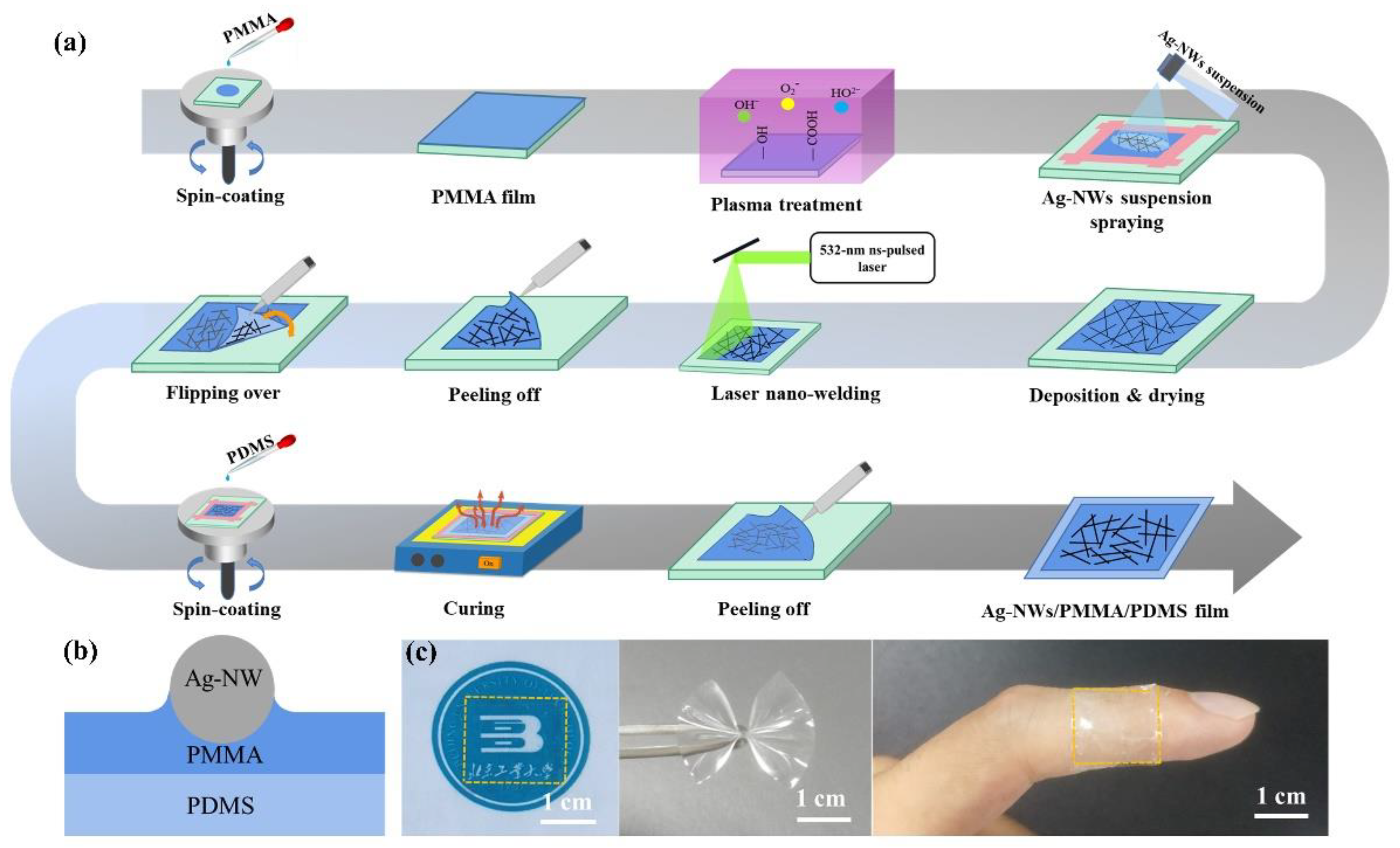
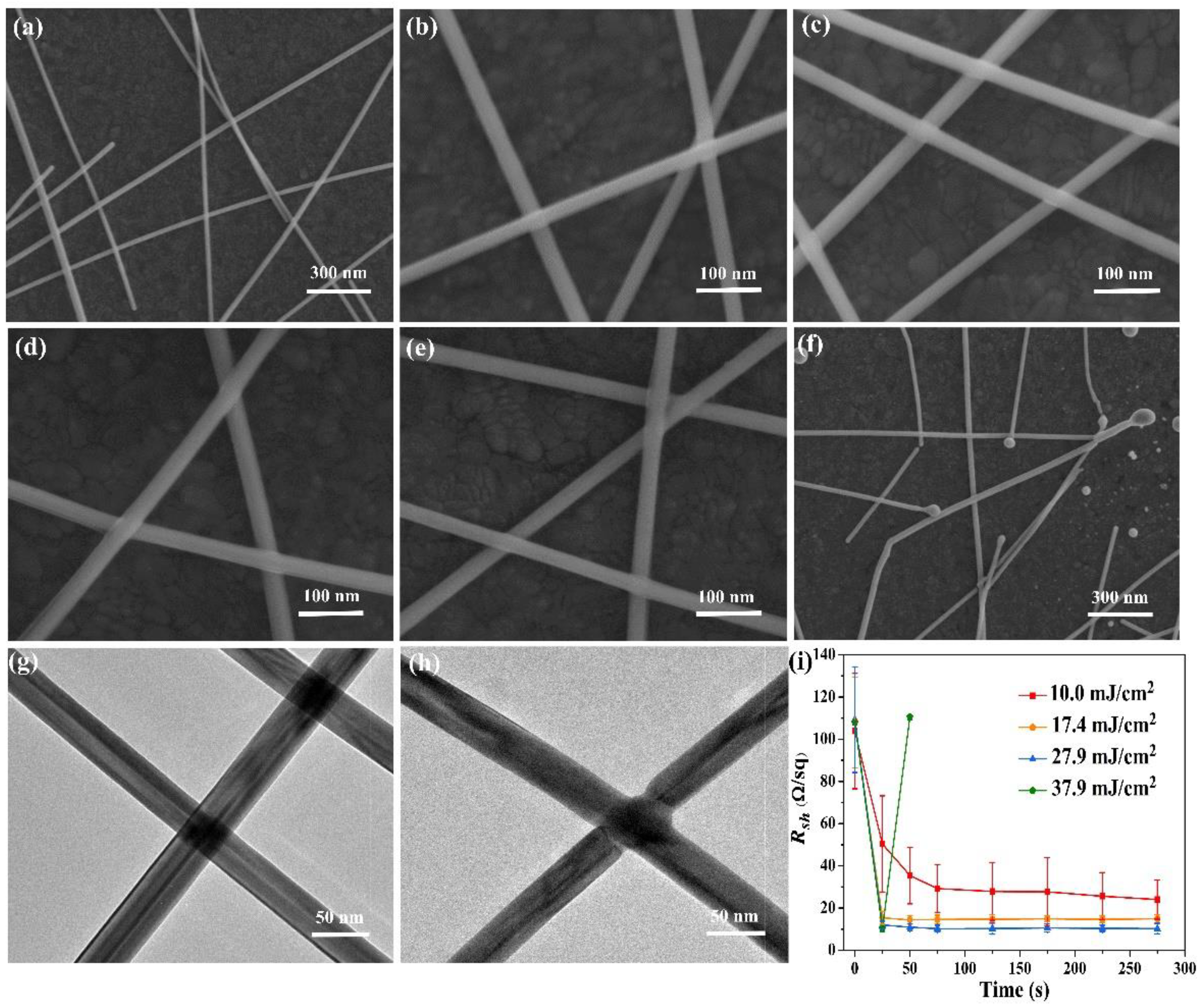
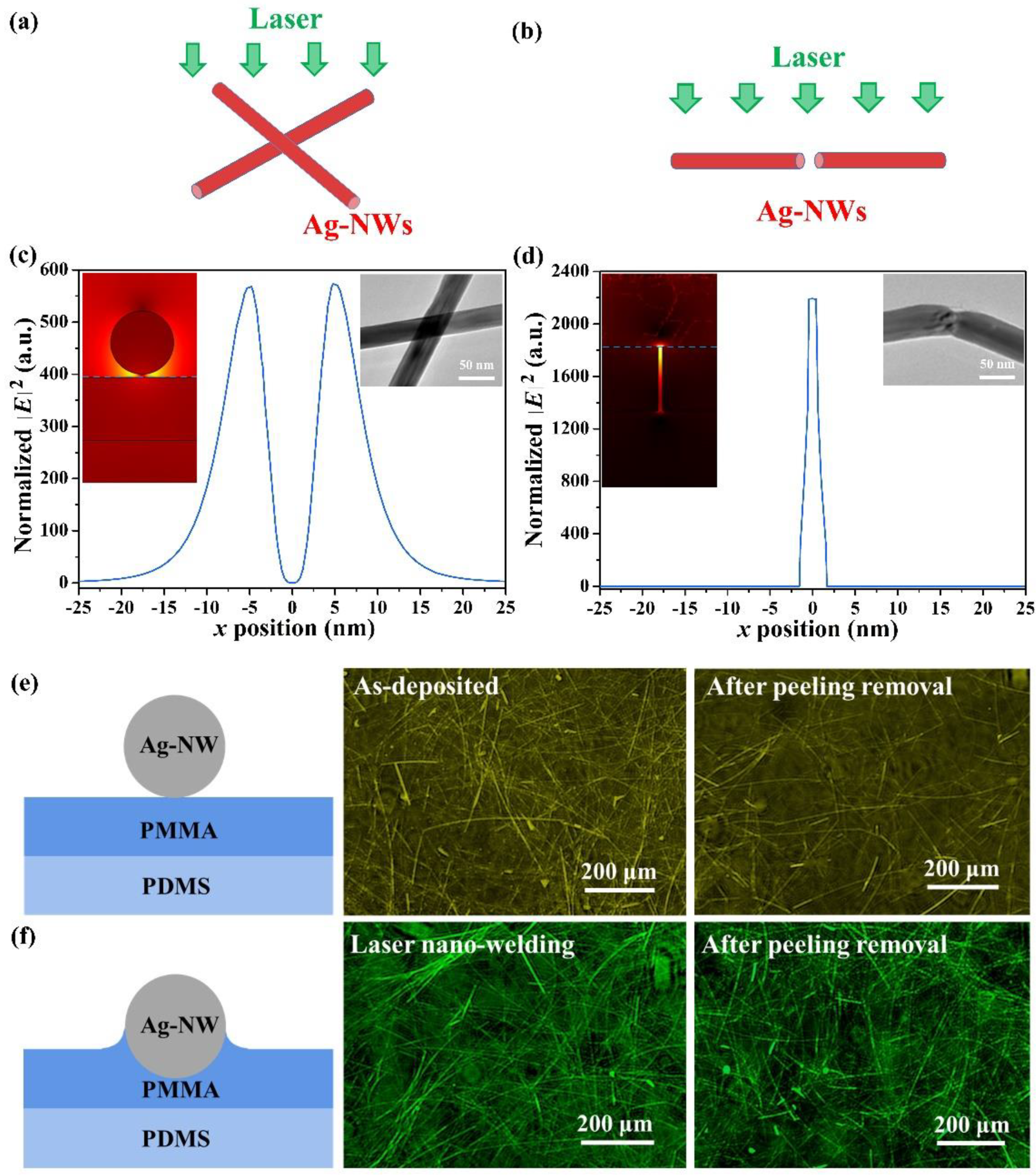
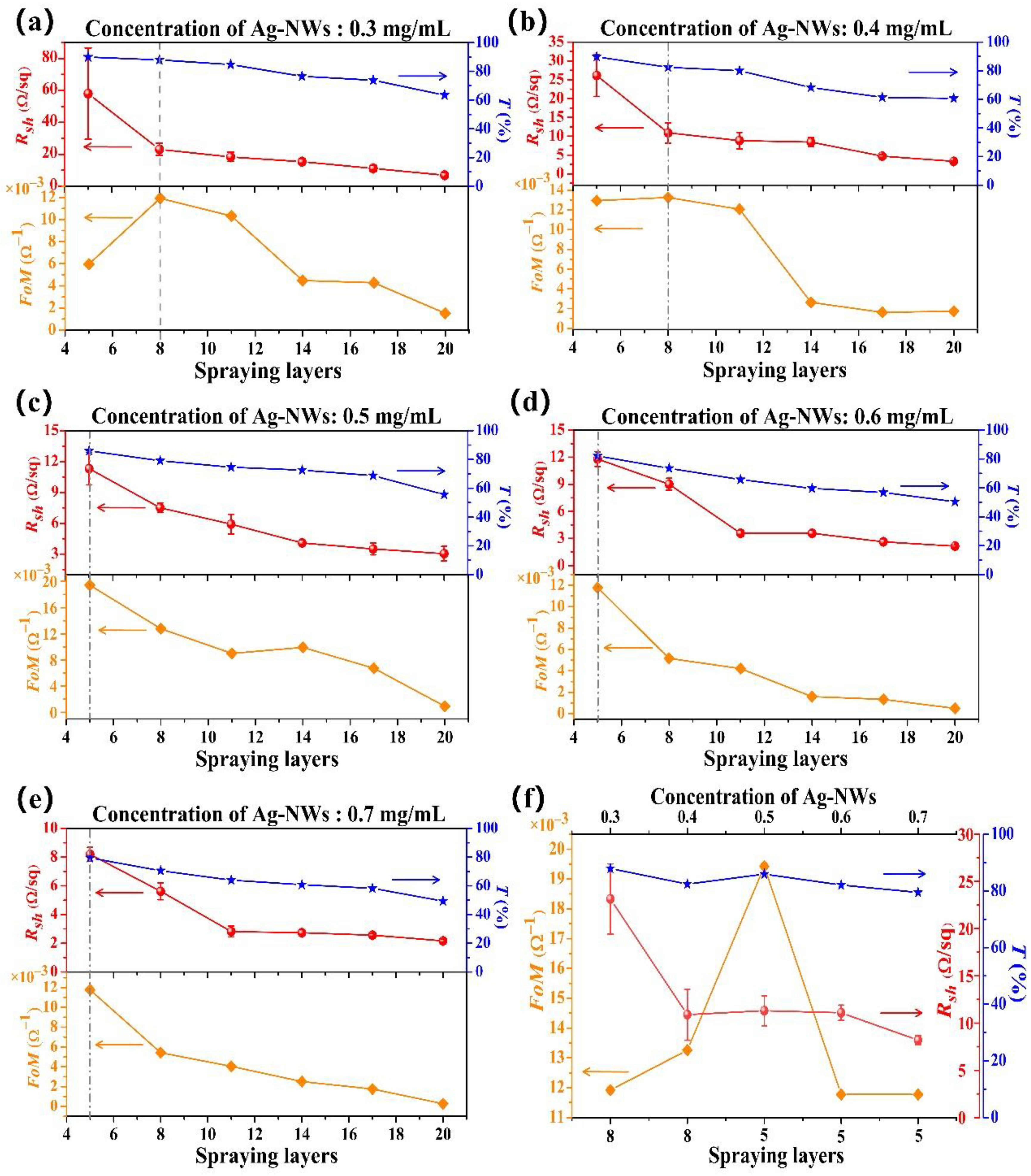
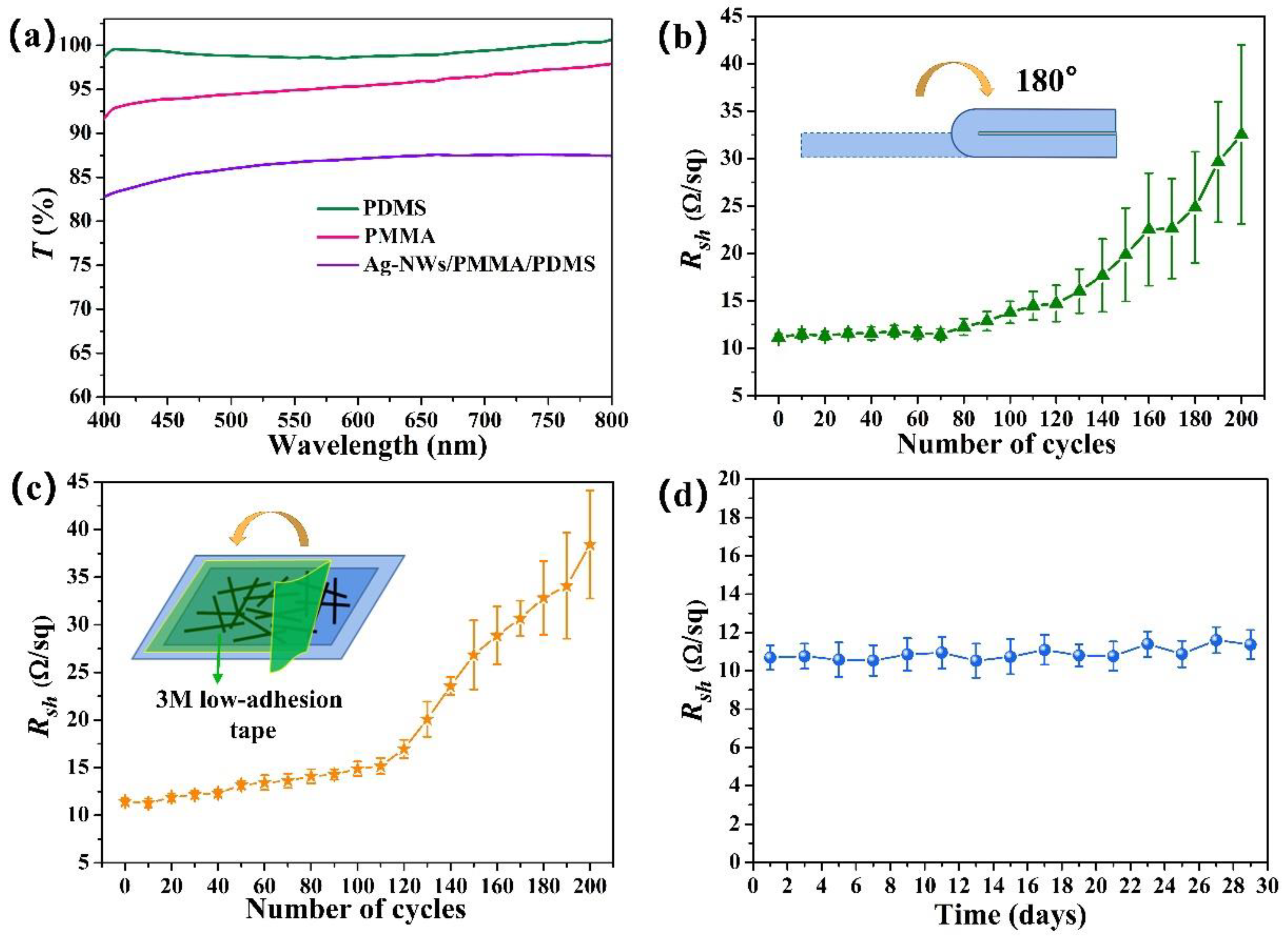
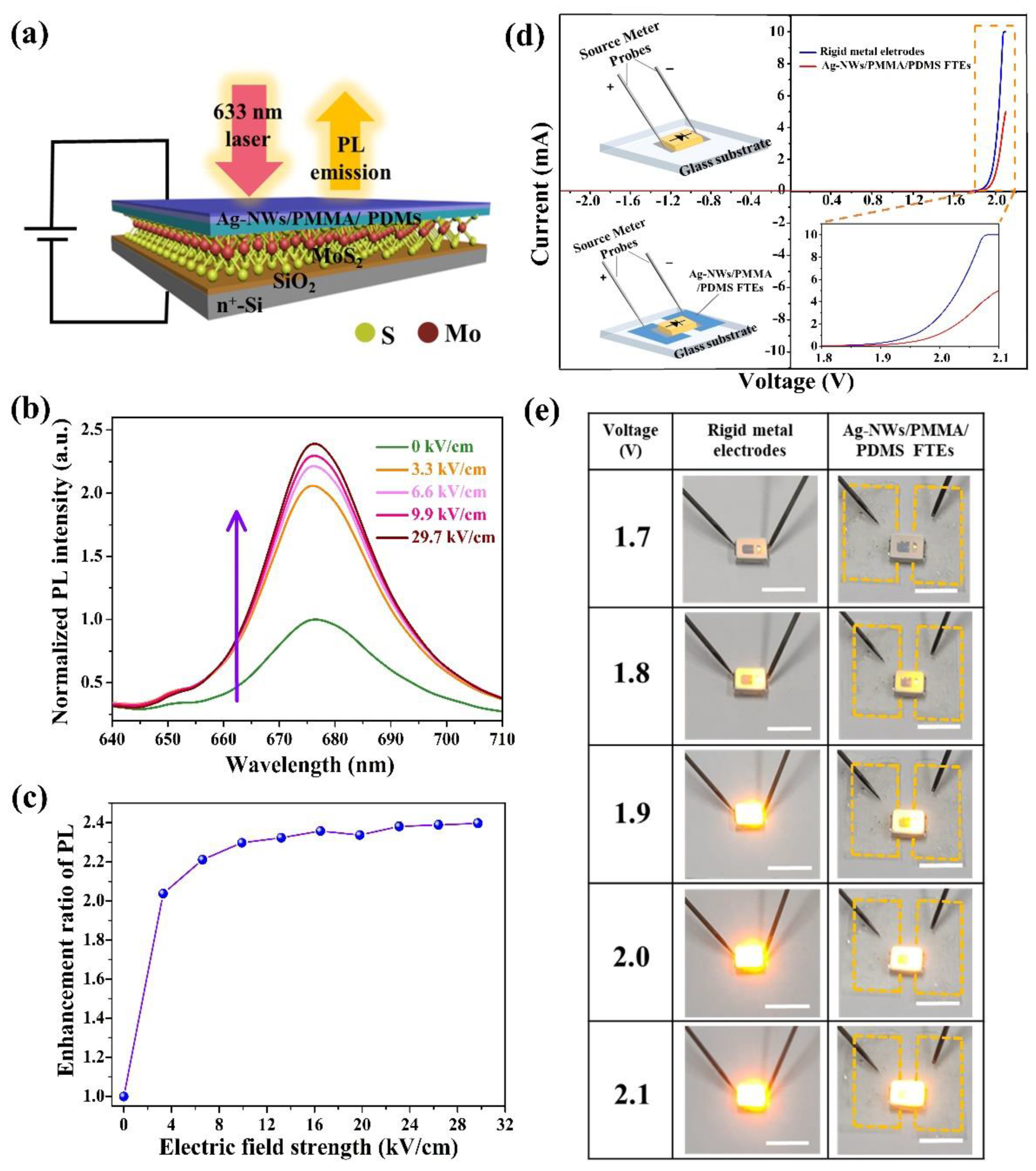
Publisher’s Note: MDPI stays neutral with regard to jurisdictional claims in published maps and institutional affiliations. |
© 2021 by the authors. Licensee MDPI, Basel, Switzerland. This article is an open access article distributed under the terms and conditions of the Creative Commons Attribution (CC BY) license (https://creativecommons.org/licenses/by/4.0/).
Share and Cite
Wang, T.; Yan, Y.; Zhu, L.; Li, Q.; He, J.; Zhang, X.; Li, X.; Zhang, X.; Pan, Y.; Wang, Y. High-Performance Flexible Transparent Electrodes Fabricated via Laser Nano-Welding of Silver Nanowires. Crystals 2021, 11, 996. https://doi.org/10.3390/cryst11080996
Wang T, Yan Y, Zhu L, Li Q, He J, Zhang X, Li X, Zhang X, Pan Y, Wang Y. High-Performance Flexible Transparent Electrodes Fabricated via Laser Nano-Welding of Silver Nanowires. Crystals. 2021; 11(8):996. https://doi.org/10.3390/cryst11080996
Chicago/Turabian StyleWang, Tao, Yinzhou Yan, Liye Zhu, Qian Li, Jing He, Xiaoxia Zhang, Xi Li, Xiaohua Zhang, Yongman Pan, and Yue Wang. 2021. "High-Performance Flexible Transparent Electrodes Fabricated via Laser Nano-Welding of Silver Nanowires" Crystals 11, no. 8: 996. https://doi.org/10.3390/cryst11080996
APA StyleWang, T., Yan, Y., Zhu, L., Li, Q., He, J., Zhang, X., Li, X., Zhang, X., Pan, Y., & Wang, Y. (2021). High-Performance Flexible Transparent Electrodes Fabricated via Laser Nano-Welding of Silver Nanowires. Crystals, 11(8), 996. https://doi.org/10.3390/cryst11080996





